The Laughing Stock of the Heartless Stars: The Brown Collection, Marylebone, London
The Laughing Stock of the Heartless Stars, curated by the British artist Glenn Brown and his husband, Edgar Laguinia is their most ambitious yet, showcasing 70 diverse artworks representing 500 years of Art History.
The title references a poem by Jules Laforgue and suggests a feeling of cosmic antipathy, the vast unknown, an uncaring universe that is indifferent to the struggles of the human soul. The exhibition explores humanity's relentless pursuit of significance in a universe without inherent meaning from an Absurdist perspective. Life is both an unavoidable tragedy and a humorous, carnival-like celebration.
The examination of the intricate and enduring struggle between nature and humanity takes centre stage in the exhibition. Numerous artistic works exalt the beauty of nature, such as the woodblock prints of Monica Poole (1921-2003) and Gertrude Hermes (1901-1983), as well as Henri Fantin-Latour's Roses Thé, 1874, that celebrates the immense beauty in nature. Brown's work skillfully confronts this intricate tension. A multitude of Brown's creations embody states of transition, decay, and the blurred line between artificial and organic forms. Take, for instance, the piece The Holy Bible, 2022, which portrays a tree trunk adorned with striking, vivid, acidic colours. Manipulating traditional representations of nature, and transforming them into something more unsettling, urges us to contemplate the extent to which we are fundamentally reshaping the natural world, possibly beyond recognition.
The earliest piece is a chiaroscuro woodcut titled Oceanus (Neptune), created by Hendrick Goltzius between 1588 and 1590. The most recent work is Deep Time Ornament, a sculpture by Phoebe Cummings from 2024. Together, these artworks illustrate the evolving relationship between art and nature, each embodying the values of their respective times. Goltzius’s piece reflects Renaissance Humanism, showcasing the duality of nature with Oceanus symbolically dominating the sea. In contrast, Cummings’s sculpture addresses contemporary environmental awareness, highlighting the transience of nature and our interaction with the environment. Despite being created four centuries apart, both works delve into humanity’s connection to nature, communicating complex ideas in the process.
The work radiates a distinct sense of baroque theatricality, emotionality, and movement, choosing to evoke strong emotions rather than allowing for quiet contemplation. Karel Appel (1921–2006) and Grace Pailthorpe (1883–1971), using loose and expressive brushstrokes to convey raw emotion, parallel the emotional intensity of the Baroque period. Even modernist sculpture such as Table Piece CLXXXII, 1974, by Anthony Caro becomes Baroque in this context, for it embodies a sense of movement and dynamism to which the Baroque period is known.
Showcasing 70 diverse artworks by 28 artists, most of the work in the exhibition has never been on public display and includes new work by Brown.
Marion Adnams (British, 1898–1995)
Philip Akkerman (Dutch, 1957– )
Karel Appel (Dutch, 1921–2006)
Nobuyoshi Araki (Japanese, 1940– )
Simon Bill (British, 1958– )
Abraham Bloemaert (Dutch, circa 1564–1651)
Glenn Brown (British, 1966– )
Carlo Innocenzo Carlone (Italian, 1686-1775)
Anthony Caro (British, 1924–2013)
Jean-Baptiste Carpeaux (French, 1827–1875)
Morris Cox (British, 1903–1998)
Phoebe Cummings (British, 1981– )
Henri Fantin-Latour (French, 1836–1904)
Mauro Gandolfi (Italian, 1764–1834)
Hendrick Goltzius (Dutch, 1558-1617)
Ernest Henri Griset (French, 1844–1907)
Gertrude Hermes (British, 1901–1983)
Ann-Marie James (British, 1981– )
Laura Knight (British, 1877–1970)
John Martin (British, 1789–1854)
Jan Harmensz. Muller (Dutch, 1571-1628)
Grace Pailthorpe (British, 1883–1971)
Monica Poole (British, 1921–2003)
Austin Osman Spare (British, 1888–1956)
Jacques Villon (French, 1875-1963)
Elias Vonck (Dutch, 1605–1652)
Anna Zinkeisen (British, 1901–1976)
Artworks
-
 Glenn BrownThe Aesthetic Poor (for Tim Buckley) after John Martin, 2002Oil on canvas220.5 x 333 cm (86 3/4 x 131 1/8 in)
Glenn BrownThe Aesthetic Poor (for Tim Buckley) after John Martin, 2002Oil on canvas220.5 x 333 cm (86 3/4 x 131 1/8 in) -
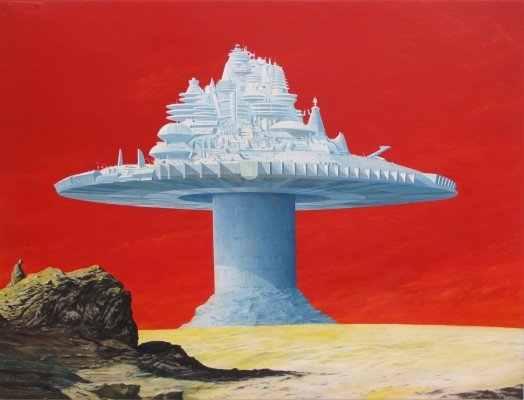 Glenn BrownThe End (Painting for Ian Curtis) after Angus McKie (copied from the illustration 'Perry Rhodan 20Thrall of Hypno'), 1996Oil on canvas mounted on board66 x 87 x 2.4 cm (26 x 34 1/4 x 1 in)
Glenn BrownThe End (Painting for Ian Curtis) after Angus McKie (copied from the illustration 'Perry Rhodan 20Thrall of Hypno'), 1996Oil on canvas mounted on board66 x 87 x 2.4 cm (26 x 34 1/4 x 1 in) -
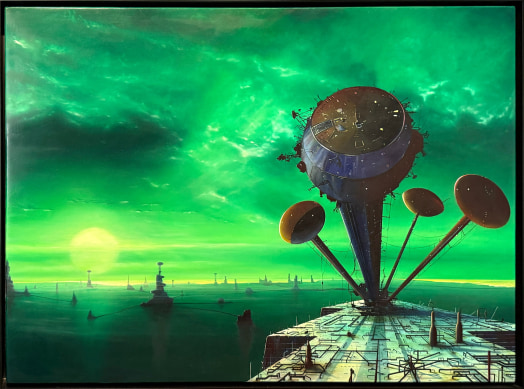 Glenn BrownEveryone Sang (Painting for Ian Curtis) after Chris Foss (copied from the illustration 'Gammaden 02'), 1996Oil on canvas mounted on board59 x 79.5 x 2.4 cm (23 1/4 x 31 1/4 x 1 in)
Glenn BrownEveryone Sang (Painting for Ian Curtis) after Chris Foss (copied from the illustration 'Gammaden 02'), 1996Oil on canvas mounted on board59 x 79.5 x 2.4 cm (23 1/4 x 31 1/4 x 1 in) -
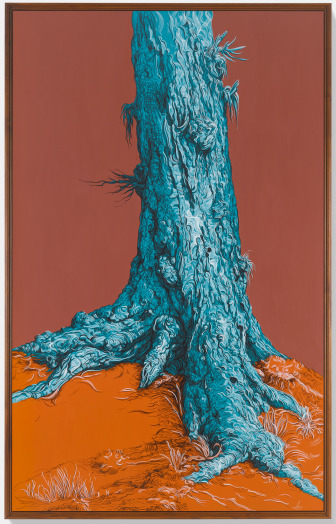 Glenn BrownThe Holy Bible, 2022Acrylic on panel198 x 123.4 x 2.2 cm (78 x 48 5/8 x 7/8 in)
Glenn BrownThe Holy Bible, 2022Acrylic on panel198 x 123.4 x 2.2 cm (78 x 48 5/8 x 7/8 in)
-
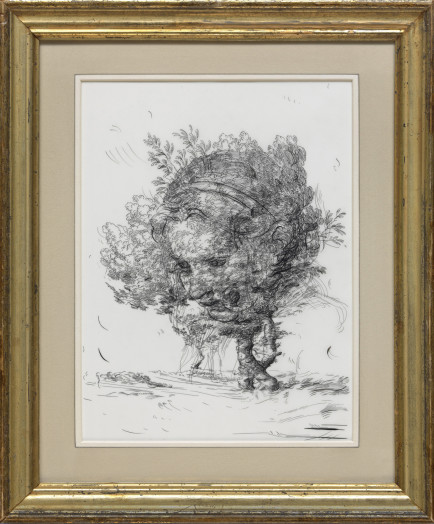 Glenn BrownDrawing 6 (after Greuze/Grimaldi), 2017India ink on polyester film, over cardboard, in frame42.1 x 29.7 cm (16 5/8 x 11 3/4 in) sheet size
Glenn BrownDrawing 6 (after Greuze/Grimaldi), 2017India ink on polyester film, over cardboard, in frame42.1 x 29.7 cm (16 5/8 x 11 3/4 in) sheet size
54.5 × 45.5 × 2.3 cm (21 1/2 × 17 7/8 × 7/8 in) framed size -
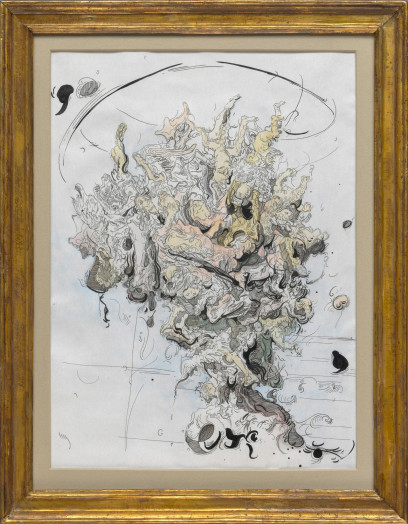 Glenn BrownDrawing 8 (after Tiepolo), 2017India ink and watercolour on paper49.9 x 36.7 cm (19 5/8 x 14 1/2 in) sheet size
Glenn BrownDrawing 8 (after Tiepolo), 2017India ink and watercolour on paper49.9 x 36.7 cm (19 5/8 x 14 1/2 in) sheet size
59.6 x 46.5 x 2.75 cm (23 1/2 x 18 1/3 x 1.1 in) frame size -
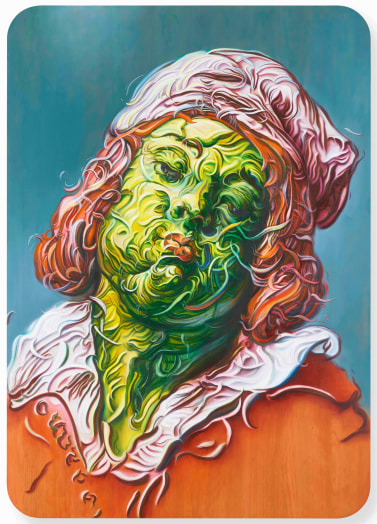 Glenn BrownDirty Creamer, 2022Oil and india ink on cherry wood panel169.7 x 120.9 x 1.8 cm (66 7/8 x 47 5/8 x 3/4 in) panel
Glenn BrownDirty Creamer, 2022Oil and india ink on cherry wood panel169.7 x 120.9 x 1.8 cm (66 7/8 x 47 5/8 x 3/4 in) panel -
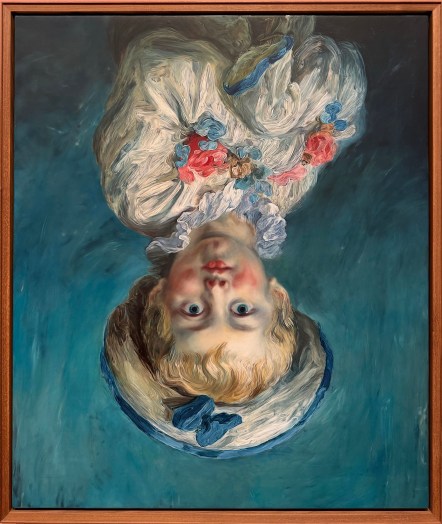 Glenn BrownSearched Hard for You and Your Special Ways, 1995Oil on canvas mounted on board89 x 75 cm (35 1/8 x 29 1/2 in)
Glenn BrownSearched Hard for You and Your Special Ways, 1995Oil on canvas mounted on board89 x 75 cm (35 1/8 x 29 1/2 in)
-
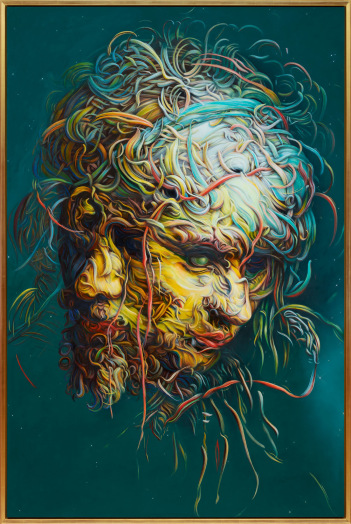 Glenn BrownDoggerland, 2022Oil and acrylic on panel216 x 144 x 2 cm (85 1/8 x 56 3/4 x 3/4 in)
Glenn BrownDoggerland, 2022Oil and acrylic on panel216 x 144 x 2 cm (85 1/8 x 56 3/4 x 3/4 in) -
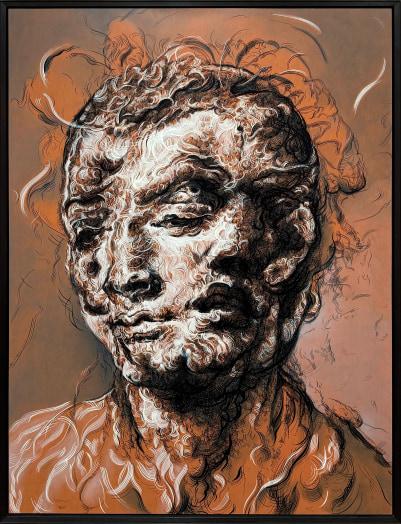 Glenn BrownThe Laughing Stock of the Heartless Stars, 2024Indian ink, acrylic and oil on panel132 x 95 cm (52 x 37 3/8 in)
Glenn BrownThe Laughing Stock of the Heartless Stars, 2024Indian ink, acrylic and oil on panel132 x 95 cm (52 x 37 3/8 in) -
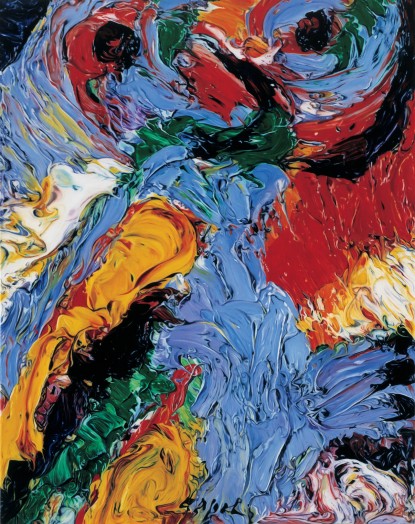 Glenn BrownWorld Without End, 1994Oil on canvas51 x 40 cm (20 1/8 x 15 3/4 in)
Glenn BrownWorld Without End, 1994Oil on canvas51 x 40 cm (20 1/8 x 15 3/4 in) -
 Glenn BrownShipwreck, Custom of the Sea, 2022-2024Oil on panel150 x 287 x 2.1 cm (59 1/16 x 113 x 13/16 in) panel
Glenn BrownShipwreck, Custom of the Sea, 2022-2024Oil on panel150 x 287 x 2.1 cm (59 1/16 x 113 x 13/16 in) panel
154.9 x 292.1 x 5.7 cm (61 x 115 x 2 1/4 inches) framed
-
 Glenn BrownDarsham Songs, 2016Oil, Indian ink and acrylic on panel82 x 129.5 cm (32 1/4 x 51 in) panel
Glenn BrownDarsham Songs, 2016Oil, Indian ink and acrylic on panel82 x 129.5 cm (32 1/4 x 51 in) panel
88.6 x 136.5 x 3.1 cm (34 7/8 x 53 3/4 x 1 1/4 in) frame -
 Glenn BrownDrawing/Painting 35 (after De Heer), 2015Indian ink and acrylic on panel75 x 60 cm (29 1/2 x 23 5/8 in)
Glenn BrownDrawing/Painting 35 (after De Heer), 2015Indian ink and acrylic on panel75 x 60 cm (29 1/2 x 23 5/8 in) -
 Glenn BrownMorbid Fancies, 2024Oil paint on marble116 x 43 x 37 cm (45 5/8 x 16 7/8 x 14 5/8 in)
Glenn BrownMorbid Fancies, 2024Oil paint on marble116 x 43 x 37 cm (45 5/8 x 16 7/8 x 14 5/8 in)
